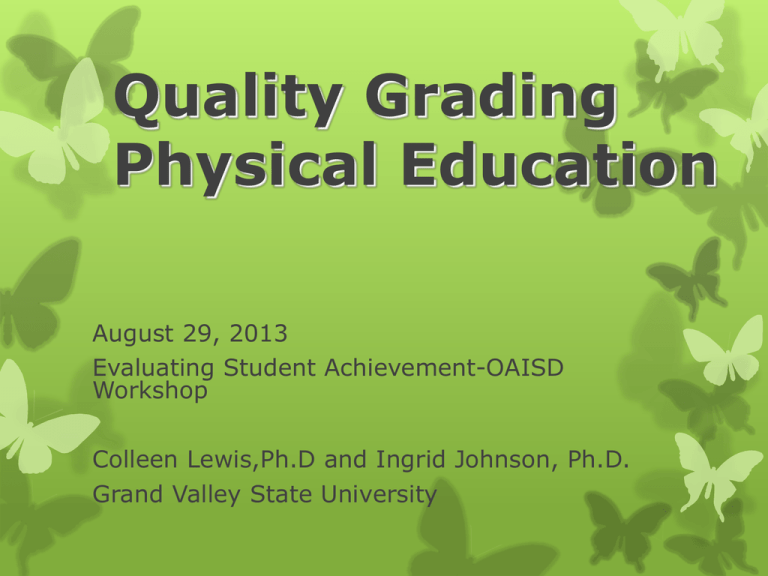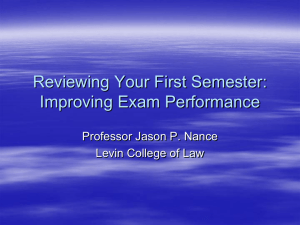Quality Grading Physical Education
advertisement

Quality Grading Physical Education August 29, 2013 Evaluating Student Achievement-OAISD Workshop Colleen Lewis,Ph.D and Ingrid Johnson, Ph.D. Grand Valley State University Grading and Assessment Grades, progress reports, and report cards are related to assessment because each is usually (and should be) derived from a variety of assessment scores. Teachers need to assess accurately and use assessment to benefit students, not merely to sort and grade students You need to have a clear purpose – why is the assessment being conducted? How will that be related to a grade for that student? Is there a clear picture of what is being measured? Do the assessments accurately reflect student learning? All three domains? Fitness? Again, how does this turn into a grade? Assessment is more than grading! Assessments should demonstrate what students KNOW or are able to do. Assessments can "show off" learning in your program. SHARE the information with students, administrators, other teachers, and parents as appropriate. (This will lend credibility to your program.) Start small (your most cooperative group, one group, one class, one grade level, a few students). Be CLEAR about the criteria (rubric standard, exemplary model, etc.) for making judgments. Allow students in on the process. (a. Using your criteria they can evaluate self, partner or others; b. allow students some choices in the manner in which they want to be assessed--include the criteria for each assessment.) Authentic assessment can be real or perceived. The more real-life, the more authentic. There are many TYPES of assessments (peer, group, projects, oral response, observation, debate, video, paper/pencil). If you are strapped for time to have students complete paper and pencil assessments, consider asking classroom teachers to help administer assessments in their classrooms. Challenges to Effective Grading Practice What to Grade? Vague or immeasurable goals/objectives Process vs. Product? Effort vs. Achievement? How to Grade? Valid Assessment tools, Criteria for evaluation, weighting of multiple measurements Meeting The Challenge: Develop Your “Philosophy of Grading” Develop Your “Grading System” Develop a Method to Calculate Final Grades Efficiently BEFORE YOU TEACH: Before you ever set foot in the school, HAVE A PLAN! *Philosophy *Objectives *Weighting *Methods Establishing a Grading Philosophy: Identify the Purposes for Grades Enhance Learning Support Achievement of Goals/Objectives Compare Grades in PE/Health vs. “Other Classes” All 3 Learning Domains- what about Fitness? Ability Grouping? Other Issues? Grades Must be Related to Stated Objectives: Final grade reflects a combination of psychomotor, cognitive and affective achievements List Examples of PE Objectives: Do this at your table/small group Did you address all the learning domains? Do they line up with the MI or NASPE standards? Looking at Those Objectives: How Do You Measure Them? Discuss at your table Try to come up with a variety of methods for evaluation Are they realistic for your situation? Do they really measure what you want them to measure? Student learning? “Weighting” the Domains Three Domains and Fitness Different “Importance” Different “weights” reflect the “importance” Let’s Take a HS Volleyball Unit: Objectives: what are they? Skills Knowledge Team Work How Would YOU Weight their relative importance? WHAT you grade and HOW you grade will affect the value that students, parents and teachers will put on your PE Program! Because it REFLECTS the value YOU and your colleagues put on it! Develop Your System: Criteria for Good Practice: Validity, Reliability, Objectivity, Simplicity In Short: FAIR If the final grade is “FAIR” It will be based on a number of VALID measures based on GOOD TESTS! It will be based on learning objectives in all 3 domains (and fitness) It will be accurately calculated and clear to students Grades Should Accurately Reflect True Achievement Validity! For Example: Objective: Students will master the underhand VB serve: Measure: Mechanics of VB serve or number of serves/attempts (!) CHALLENGE: How do you measure “effort”? The Test Will be Consistent: Reliability! The more consistent the scores are, the more reliable the grade is! Grades Won’t Reflect “Personality Conflicts”… Objectivity: Interpretation of “good form” may vary from teacher to teacher… Rating scales and checklists “objectify” otherwise subjective measurements Teachers Should Teach – Not Grade… Grades are important!!! – But should never interfere with teaching and learning! Think of ways to simplify the task Keep It Simple Have a System Explain the System If a student is ever “surprised” by his/her grade – could it be that “The System” was either too confusing or too mysterious? Variety is Good: Formal vs. Informal Assessment Daily grades Quick Quizzes: P/F Student Portfolios Formal Skills Tests One Last Word: You don’t have to reinvent the wheel- there are great resources out there!











